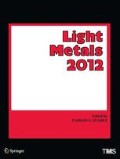Abstract
A mathematical model of magnetohydrodynamic (MHD) effects in an aluminium cell using numerical approximation of a finite element method is presented. The model predicts the current distribution in the cell and calculates the Lorentz force from the external magnetic field in molten metal for cathode blocks with different surface inclinations.
The findings indicated that the cathode surface inclinations have significant influence on cathode current density and Lorentz field distribution in the molten metal. The results establish a trend for the current density and associated MHD force distributions with increase in cathode inclination angle, φ. It has been found that cathode with φ = 5° inclination could decrease 16 to 20% of Lorentz force in the molten metal.
Access this chapter
Tax calculation will be finalised at checkout
Purchases are for personal use only
Preview
Unable to display preview. Download preview PDF.
References
T. Sele, “Instabilities of the metal surface in electrolytic alumina reduction cells,” Metallurgical Transactions B, 8(4) (1977), 613–618.
N. Urata, “Magnetics and Metal Pad Instability. in Light Metals: Proceedings of Sessions,” AIME Annual Meeting (Warrendale, Pennsylvania) 1985.
A.D. Sneyd, “Stability of Fluid Layers Carrying a Normal Electric Current,” Journal of Fluid Mechanics, 156 (1985) 223–236.
A.D. Sneyd, and A. Wang, “Interfacial instability due to MHD mode coupling in aluminum reduction cells,” Journal of Fluid Mechanics, 263 (1994), 343–359.
D.P. Ziegler, “Stability of metal/electrolyte interface in Hall-HeÌ⎕roult cells: Effect of the steady velocity,” Metallurgical Transactions B, 24(5) (1993), 899–906.
D. Billinghurst, et al., “Development of B32 cell technology,” TMS Light Metals, (2006), 255–257.
E.D. Tarapore, “Effect of Some Operating Variables on Flow in Aluminum Reduction Cells,” Journal of Metals, 34(2) (1982), 50–55.
K.J. Fraser, et al., “Some applications of mathematical modelling of electric current distributions in Hall Heroult cells,” TMS Light Metals, (1989), 219–226.
K. Vasshaug, et al., “Formation and dissolution of aluminium carbide in cathode blocks,” TMS Light Metals, (2009), 1111–1116.
Y. Sato, P. Patel, and P. Lavoie, “Erosion measurements of high density cathode block samples through laboratory electrolysis with rotation,” TMS Light Metals, 2010, 817–822.
A.T. Tabereaux, et al., “Erosion of cathode blocks in 180 kA prebake cells,” TMS Light Metals, (1999), 187–192.
H.A. Oye and B.J. Welch, “Cathode performance: The influence of design, operations, and operating conditions,” JOM, 50(2) (1998), 18–23.
D. Lombard, et al., “Aluminum Pechiney experience with graphitized cathode blocks,” TMS Light Metals, (1998), 653–658.
S. Das, G. Brooks and Y. Morsi, “Theoretical Investigation of the Inclined Sidewall Design on Magnetohydrodynamic (MHD) Forces in an Aluminum Electrolytic Cell,” Metallurgical and Materials Transactions B, 42(1) (2011), 243–253.
Z. Wang, et al., “Study of surface oscillation of liquid aluminum in 168kA aluminum reduction cells with a new type of cathode design,” TMS Light Metals, (2010), 485–488.
R. Von Kaenel and J. Antille, “Modeling of energy saving by using cathode design and inserts,” TMS Light Metals, (2011), 569–574.
R. Moreau, and J.W. Evans, “Analysis of the Hydrodynamics of Aluminum Reduction Cells,” Journal of the Electrochemical Society, 131(10) (1984), 2251–2259.
M.A. Doheim, et al., “Modeling and measurements of metal pad velocity in 208 kA end to end prebaked cells,” TMS Light Metals, (2008), 419–424.
A. Moraru and A. Panaitescu. “Navier-stokes equations in presence of laplace forces in the aluminum reduction cell,” TMS Light Metals, (2006), 521–626.
D.S. Severo, et al., “Comparison of various methods for modeling the metal-bath interface,” TMS Light Metals, (2008), 413–418.
Q. Xiquan, et al., “Study of current distribution in the metal pad of aluminum reduction cells,” TMS Light Metals, (2009), 575–580.
S. Wilkening, and P. Reny, “Erosion rate testing of graphite cathode materials,” TMS Light Metals, (2004), 597–602.
Author information
Authors and Affiliations
Editor information
Editors and Affiliations
Rights and permissions
Copyright information
© 2012 TMS (The Minerals, Metals & Materials Society)
About this chapter
Cite this chapter
Das, S., Littlefair, G. (2012). Current Distribution and Lorentz Field Modelling Using Cathode Designs: A Parametric Approach. In: Suarez, C.E. (eds) Light Metals 2012. Springer, Cham. https://doi.org/10.1007/978-3-319-48179-1_146
Download citation
DOI: https://doi.org/10.1007/978-3-319-48179-1_146
Publisher Name: Springer, Cham
Print ISBN: 978-3-319-48570-6
Online ISBN: 978-3-319-48179-1
eBook Packages: Chemistry and Materials ScienceChemistry and Material Science (R0)

